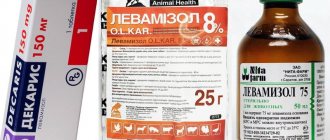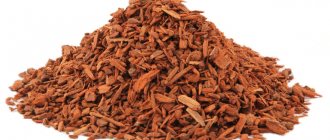Oxytetracycline hydrochloride – Oxytetracyclini hydrochloridum
- Name: Oxytetracycline.
Synonym: geomycin. - Yellow crystalline powder, bitter taste, easily soluble in water.
- Available in bottles of 0.1 and 0.2 g.
- Oxytetracycline has a wide range of effects. It has an effective effect on many gram-positive and gram-negative bacteria, as well as mycoplasmas, spirochetes, rickettsia, chlamydia and protozoa.
- Used for the treatment of infectious diseases of animals caused by pathogens sensitive to tetracycline, such as pneumonia, bronchopneumonia, enteritis, as well as secondary bacterial infections associated with viral diseases. Oxytetracycline hydrochloride can be used as a means to prevent infectious complications after surgery, as well as for the treatment of infected wounds and abscesses.
- The drug is contraindicated in severe diseases of the liver, kidneys, and hematopoietic system.
- Administered intramuscularly to dogs and cats at a dose of 10-30 mg/kg 2 times a day.
- Similar drugs are produced abroad under various commercial names. For parenteral administration, oxytetracycline preparations in a complex polymer solvent are used. Polskaya produces oxytetracycline under the name Oxyven.
1 ml of the drug contains 50 mg of oxytetracycline hydrochloride. Available in 50ml bottles. It is administered intramuscularly to dogs of large breeds 1 ml/10 kg, and to other carnivores - 1 ml/5 kg body weight. - , Germany supplies Urcycline to our country. 100 ml of the drug contains 5 g of oxytetracycline hydrochloride. Available in bottles of 50 and 100 ml. Administered subcutaneously to dogs and cats at a dose of 0.1-0.2 ml/kg (5-10 mg/kg). For enteral use, similar drugs come from Poland under the name "Mepatar" and Croatia - "Geomitsin". They are used to treat infectious diseases of the gastrointestinal tract and respiratory tract infections. Oxycort is a combination drug in an aerosol package containing 0.3 g of oxytetracycline hydrochloride, 0.1 g of hydrocortisone and up to 75 ml of solvent. The drug combines the antibacterial effect of oxytetracycline with the anti-inflammatory effect of hydrocortisone. Used to treat infected eczema, wounds, pustular skin diseases, erosions, burns.
special instructions
In order to prevent hypovitaminosis, you should take vitamin K and group B , brewer's yeast .
There is a risk of developing photosensitivity , which requires limiting insolation .
Long-term treatment involves periodic monitoring of the functional state of the liver, kidneys and hematopoietic organs.
Since the drug can mask the symptoms of syphilis and possible mixed infection , a monthly serological test is performed for 4 months.
Pharmacology and mechanism of action
Oxytetracycline is a tetracycline antibiotic.
The mechanism of action of tetracyclines is to bind to the 30S ribosomal subunit and inhibit protein synthesis. Oxytetracycline is usually a bacteriostatic antibiotic. It has a wide spectrum of activity, including gram-positive and gram-negative bacteria, some protozoa, Rickettsiae and Ehrlichiae. The spectrum also includes chlamydia, spirochetes, mycoplasmas, L-form bacteria and some protozoa (Plasmodium and Entameba). Resistance is common among Gram-negative Enterobacteriaceae (eg Escherichia coli). Oxytetracycline was available in various formulations to control the rate of release from injection. Carriers include polyethylene glycol, propylene glycol, povidone or pyrrolidine. Although oral medications are available, oral absorption is poor. For example, oral absorption of 44 mg/kg in dogs was variable and too low to produce a therapeutic effect. In pigs, oral absorption was only 4% (compared to chlortetracycline which is 13%). Most pharmacokinetic studies have been conducted using injectable oxytetracycline. Following intramuscular injection in cattle, the half-life is approximately 21 hours with a maximum concentration (CMAX) of 5.6 mcg/ml. In horses, the elimination half-life (e/v) was approximately 10-13 hours. In pigs, the half-life (e.g.) was approximately 4-6 hours.
Form
If you have animals at home and have visited a veterinarian, you may already know what oxytetracycline hydrochloride is for animals. Instructions for use describe two dosage forms that are used in world practice:
- For intramuscular injection.
- Solution for oral administration.
The maximum effect is observed after oral administration approximately 10 hours, and 14-16 after intramuscular administration. In addition, your doctor may prescribe topical application in the form of ointments and powders. Oxytetracycline hydrochloride is low toxic and practically harmless for animals. The instructions emphasize that exceeding recommended dosages is unacceptable, despite proven safety.
Indications and clinical use in veterinary medicine
Oxytetracycline is used to treat animals with respiratory tract infections (pneumonia)
, urinary tract, soft tissues and skin. It is used to treat animals with infections caused by a wide range of bacteria, with the exception of those nosologies where resistance is common among gram-negative bacteria of intestinal origin and staphylococci. Thus, oxytetracycline is not used in animal gastroenterology. One of the most common uses of oxytetracycline in cows is for the treatment of bovine respiratory disease (BRD) caused by Pasteurella multocida, Mannheimia haemolytica and Histophilus somni (formerly Haemophilus somnus). In pigs, tetracyclines are used to treat atrophic rhinitis, pulmonary pasteurellosis and mycoplasma infections. In small animals, doxycycline is widely used rather than oxytetracycline, which is used to treat Rickettsiae and Ehrlichiae. In horses, oxytetracycline was administered to treat equine piroplasmosis caused by Theileria equi, but was not effective against Babesia caballi.
Oxytetracycline has been used to treat Potomac fever in horses caused by Neorickettsia risticii, as well as respiratory and soft tissue infections. In newborn horses, oxytetracycline was administered in high doses to correct angular deformities of the limbs. Doses were as high as 50-70 mg/kg IV, every 48 hours. This effect may be caused by a decrease in viscoelastic properties in the tendons of young animals. Because it causes tendon or ligament weakness, it can correct angular deformities of the limbs in young foals.
Contraindications
This is, first of all, increased sensitivity to tetracycline drugs. It is not recommended for use in cases of cardiac and liver dysfunction, and is also not recommended for use during pregnancy. It is forbidden to prescribe simultaneously with penicillin. For the rest, be sure to consult your doctor. The duration of the course and daily dosages depend on many factors, so the instructions should be taken as informational information only. In parallel with the antibiotic, medications are prescribed that help normalize intestinal function and restore microflora.
Precautionary measures. Adverse reactions and side effects
Tetracyclines can cause renal tubular necrosis at high doses, but this is rare at recommended doses. Tetracyclines may affect bone and tooth formation in young animals. (Note that no side effects were observed in the young foal treatment studies mentioned above.) These have been associated with drug fever in cats. Hepatotoxicity may occur at high doses in highly hypersensitive individuals. Administration of oxytetracycline to horses has been associated with colic and diarrhea.
Instructions for use in veterinary medicine
Oral dosage forms are intended for use in large animals. The use of long-acting injectable forms has not been studied in small animals. The use of tetracyclines in small animals is mainly based on doxycycline or minocycline. For large animals, there is both a regular and long-acting formula. The extended-release formulation contains a viscosity excipient used to prolong absorption at the injection site. One such excipient is 2-pyrrolidone. When using long-acting veterinary drugs, long-acting properties apply only to intramuscular use and not to intravenous administration. When long-acting products are compared to conventional injectable products, long-acting products generally allow for longer dosing intervals. However, in pigs there was no difference in the duration of plasma concentrations when administered at equivalent doses.
Interaction
In combination with the following drugs, drug interaction reactions or changes in pharmacokinetics are possible:
- With magnesium-, aluminum-, calcium-, and iron-containing antacids , absorption deteriorates.
- With anticoagulants, of hypoprothrombinemia increases .
- With bactericidal antibiotics ( penicillins and cephalosporins ), a decrease in their effectiveness is observed.
- With Streptomycin , Gentamicin , activity against intracellular pathogens increases (for example, Brucella , Pasteurella ).
- With Chymotrypsin, the concentration and circulation time of oxytetracycline increases.
- With estrogen-containing oral contraceptives, their effectiveness decreases and the risk of breakthrough bleeding .
- With Retinol intracranial pressure increases .
Regulatory information
- Time for breeding cattle and pigs for meat: 7 days (oral tablets). For an orally soluble powder, elimination time varies greatly from one product to another for cattle and pigs. Typically they are at least 5 days for meat, but refer to the specific product label for removal times.
- Slaughter time for oxytetracycline injection solution for cattle: 18-22 days, depending on the drug.
- Slaughter time for slaughter of cattle using long-acting formulations: 28 days.
- Time of slaughter of cattle for milk: 96 hours at a dose of 20 mg/kg.
- Cattle slaughter time (intrauterine administration): 7 days for milk and 28 days for meat. Hatching time for cattle (intramammary): 6 days for milk and 28 days for meat.
- Pig slaughter time: from 28 days to 42 days, depending on the product.
Learn about the main antimicrobials in animals
- Yodez
- Vibramycin
- Iodoform
- Use of iodinol in animals
- Kanamycin
- Uses of iodine
- Iodopyrone
- Potassium permanganate
- Sinulox in veterinary medicine
- Bactrim
- Ampicillin
- Benzylpenicillin
- Griseofulvin
- Diamond green
- Hexamethylenetetramine
- Tobramycin eye drops
- Natural penicillins
- Nystatin
- Oxacillin
- Neomycin
- Metronidazole
- Furadonin
- Penicillins in animals
- Methylene blue
- Tsiprovet tablets
- Levofloxacin for animals
- Tsiprovet drops for veterinary medicine
- Amikacin
- Lincomycin
- Imipenem
- Ketoconazole
- Itraconazole
- How to dilute cefazolin?
- Instructions for veterinary use of phthazine
- Tobramycin in veterinary medicine
- Cephalexin
- Amoxicillin in veterinary medicine
- Gentamicin for animals
- Use of cefazolin in veterinary medicine
- Enrofloxacin in veterinary medicine
^Top





